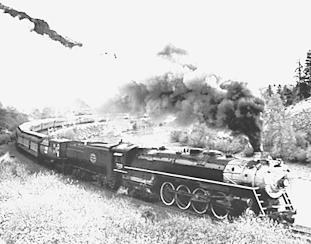

SP&S 700 pulling a 14-car excursion train in Yakima Canyon, 1991. Photo by Randal O'Toole
For many years, nearly all of the SP&S' locomotives were hand-me-downs from its parents, the Great Northern and Northern Pacific. By the mid-1930s, the railroad was woefully underpowered. Its largest passenger locomotives were Pacifics (4-6-2s), its largest freight engines were Mikados (2-8-2s), and the newest of these had been built in 1920. The SP&S had a hard time competing against newer, larger power owned by the UP, its competitor across the Columbia.
Finally, in 1937, parents NP and GN allowed the SP&S to purchase its first new locomotives: three Northerns (4-8-4s), mainly for passenger service; and six challengers (4-6-6-4s), for freight service. Except that they burned oil instead of coal, these locomotives were identical in design to Northerns and challengers built for the Northern Pacific Railway.
Baldwin Locomotive Works delivered the 700, 701, and 702 in 1938. After showing the 700 off to communities along the line, the SP&S quickly put them to work hauling passenger trains between Spokane and Vancouver, Washington. Typically, the 700 and 702 would pull overnight trains between the two towns while 701 was used for freight service and as a standby in case one of the others was out of service. The Northerns did not go into Portland until 1943 because the turntable in that city was not long enough to turn them.
In 1947, the Great Northern streamlined its premiere train, the Empire Builder, and started using Diesels for all its transcontinental passenger trains. The SP&S also purchased Diesels, but they arrived after the streamlined cars so for a few months the 700s pulled the Portland section of the Empire Builder.
The 700s continued to pull secondary passenger trains in the late 1940s and early 1950s. But by 1954, Diesels had completely displaced them in passenger service. The Northerns were used for freight trains until 1955, when enough Diesels had arrived that the railroad thought it would no longer need steam.
In May, 1956, the SP&S spruced up the 700, painting its normally grey smokebox silver, and sent it out for one last run. The "farewell to steam" run attracted hundreds of passengers, and the SP&S had to borrow passenger cars from the GN and NP to meet the demand. A total of 21 cars carried 1,400 passengers from Portland to Wishram, Washington, in the heart of the Columbia Gorge, and back on May 20.
After the trip, the 700 was placed on the scrap line with the 701, 702, challengers, and other SP&S locomotives. But the Union Pacific had offered to donate a steam locomotive to the city of Portland for display in a park. Not to be outdone by its competitor, the SP&S volunteered the 700. The two locomotives were placed in the park in 1958, and were shortly followed by the SP 4449. They sat together for nearly two decades.
![]()
In 1975, the SP 4449 was restored for operation on the American Freedom Train. One of the volunteers on the freedom train project was only 15 years old and was considered too young to go out on the road with the locomotive. So, when the 4449 left town, Chris McLarney started working on the 700, cleaning and oiling various parts.
McLarney started the PRPA in 1977 to provide support for his restoration work. Over the next few years, other people joined the PRPA to help restore the 700. With support from the Burlington Northern and many other companies and individuals, the locomotive was ready for operation in 1990.
Today, the 700 is fully operational. Since 1990 it has carried thousands of passengers on routes in various parts of the Northwest. Since it is such a large locomotive, operation is expensive. Still, the PRPA is looking forward to many excursions in the future.
![]()